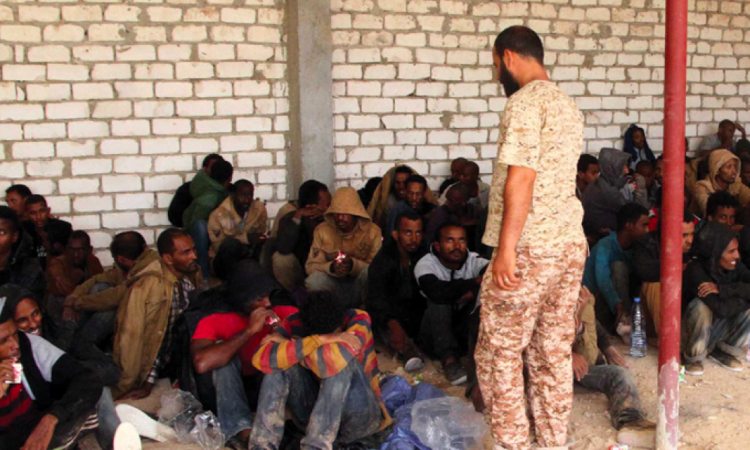The geographical human trafficking routes are complex. The FATF report considered these routes and found that it affects virtually all countries around the globe. The report considered countries of origin, transit countries and countries of destination.
However, the collective understanding of human trafficking has evolved since the time of the previous FATF report. The UNODC Global Report on Trafficking in Persons 2016 identified more than 500 different trafficking flows, including both domestic and transnational human trafficking. Accordingly, this report takes a modernised approach and considers domestic, regional and trans-regional trafficking flows.
The aggregated global figure shows that most detected trafficking victims globally are citizens of the countries where they are detected. In 2016, more than half of the victims whose citizenships were reported were detected in their own countries. This pattern, however, changes in the different regions considered.
A relevant share of the detected victims is trafficked within the same region, with most of these victims trafficked within the same subregion (for example, within North American countries, or within sub-Saharan Africa). Less than one victim out of every ten detected in 2016 were trafficked trans-regionally. For example, victims were trafficked from South Asia to the Middle East, or from East Asia to Western and Southern Europe.
Share of detected victims by area of origin and detection 2016 (or most recent)
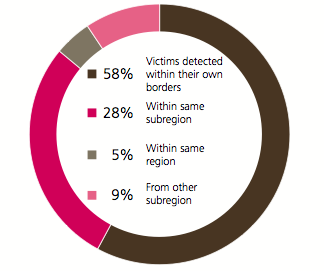
Number of victims by area of origin and of detection, by region, 2016 (or most recent)
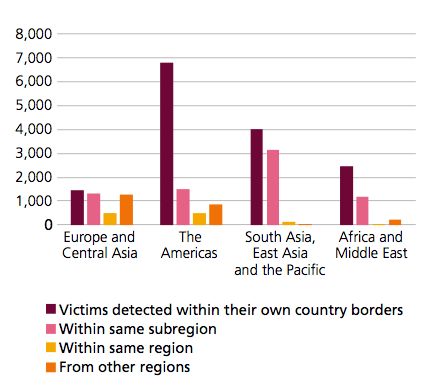
Domestic human trafficking flows
Domestic trafficking involves the movement of victims within a country between areas, or within their local area. Where there is movement of victims domestically, this commonly occurs from rural zones to cities or tourist centres, or from villages to industrial or economic hubs.
Studies show that the majority of forced labourers in economic activities, and almost all those in state-imposed forced labour, have not moved away from their home area. The UNODC found that 43% of victims in the period 2012-2014 were trafficked domestically. The 2017 Global Estimates of Modern Slavery found that only one in four victims of forced labour were exploited outside their country of residence.
Trend in the share of detected domestic victims, 2010-2016
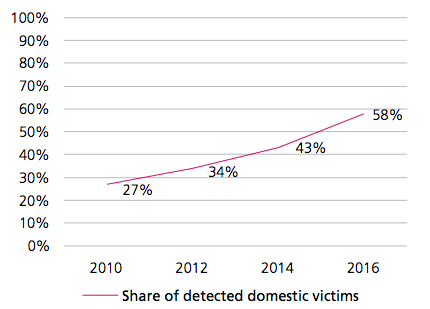
Since 2010, there has been a significant and steady increase in the share of victims detected within their own country’s borders. The share of identified domestic victims has more than doubled over the last few years, from 27 per cent to 58 per cent in 2016. This marked increase could reflect an increased volume of people trafficked in their own countries. In countries characterised to be more typically destinations of cross border trafficking, this may be the result of improved controls at borders, hence more difficulties to traffic victims from abroad. In typical origin countries, improved border controls could also result in more victims being intercepted during the process to be transferred abroad.
In this scenario, victims could be recruited for the purpose of being exploited abroad, but detected before leaving the country.
The increasing detection of domestic victims could also be explained in terms of an increased awareness among relevant authorities about domestic trafficking, or in terms of a broadening jurisprudence. National authorities may be prosecuting under the offence of trafficking in persons some cases, which would have been previously recorded under other criminal offences, such as pandering or exploitative labour conditions.
The share of detected domestic victims is very high compared to foreign victims in nearly all areas of the world, excluding Western and Central Europe, the Middle East and in the affluent countries of East Asia, where the number of foreign victims detected are higher.
Moreover, Western and Southern Europe, the affluent countries of the Gulf Cooperation Council in the Middle East, as well as North America are destinations with significant levels of inbound trafficking from other regions.
Share of victims detected within their own country’s borders, by subregion, 2016 (or most recent)
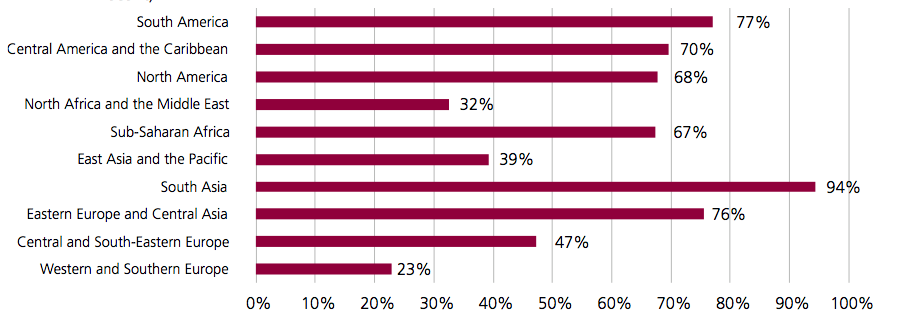
Shares of victims of trafficking repatriated to their country of origin, by repatriating country, 2014-2017
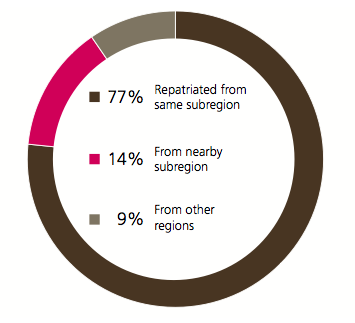
Share of detected victims by area origin and of detection, by subregion, 2016 (or most recent)
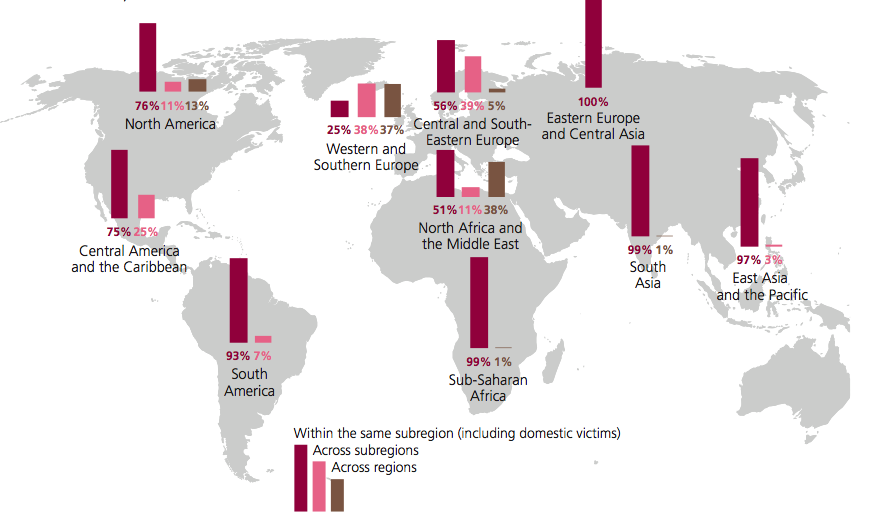 Trafficking within regions
Trafficking within regions
Transnational trafficking flows are increasingly complex – victims are exploited within and between regions. While many countries are source and destination countries, most countries tend to be either predominantly a source or predominantly a destination of trafficking victims. The UNODC found most victims detected were trafficked within the same geographical region. For the majority of detected victims of transnational trafficking identified in the UNODC’s study, the origin country was in the same geographical region as the destination, which includes domestic trafficking.
Common regional trafficking flows include victims trafficked from South-Eastern Europe to Western Europe, from the Andean countries to the Southern Cone in South America, from East Asia to the Pacific, or victims trafficked across a single international border into neighbouring countries.
Repatriation data can highlight trafficking flows that are not captured by detection data. Overall, this data confirms the general characteristics of trafficking flows; most trafficking flows are of limited geographical reach. Repatriation data only refer to cross-border trafficking – a victim of domestic trafficking cannot be repatriated. These results are in line with the 2012 and 2014 data, showing that in many countries victims are usually trafficked within the same subregion.
When victims are repatriated from other areas, these are generally in geographic proximity. North African victims, for instance, are repatriated from the Middle East or from Western Europe. Sub-Saharan Africans are trafficked to and repatriated from other countries in sub-Saharan Africa, but also from North Africa and the Middle East.
Shares of victims of trafficking who were repatriated to their country of origin, by victims’ region of origin and trafficking destination, 2014-2017
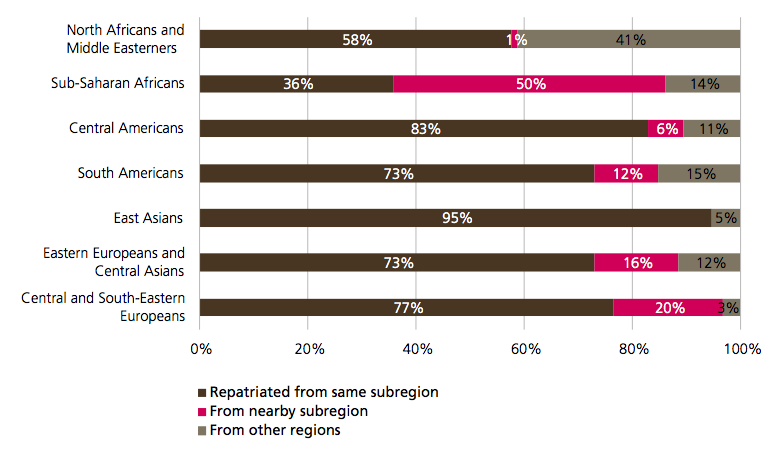
In addition to highlighting flows that are not captured by detection data, repatriation data can also help shed light on trafficking flows. Information not easily gleaned only from detection data from destination countries can particularly provide information on those destination countries which do not report trafficking cases. For example, repatriation data reveal a trafficking flow from sub-Saharan Africa towards the Middle East and North Africa.
Trans-regional trafficking
In trans-regional trafficking, countries with developed economies remain key destinations, while victims tend to originate from countries with less developed economies. The UNODC found that the Middle East, as well as most countries in Western and Southern Europe and North America, reported being destinations for trans-regional and long-distance trafficking. In particular, they found that the wealthier the country of destination, the greater the number of detected victims from outside the immediate region.
Main detected transregional trafficking flows, 2014-2017
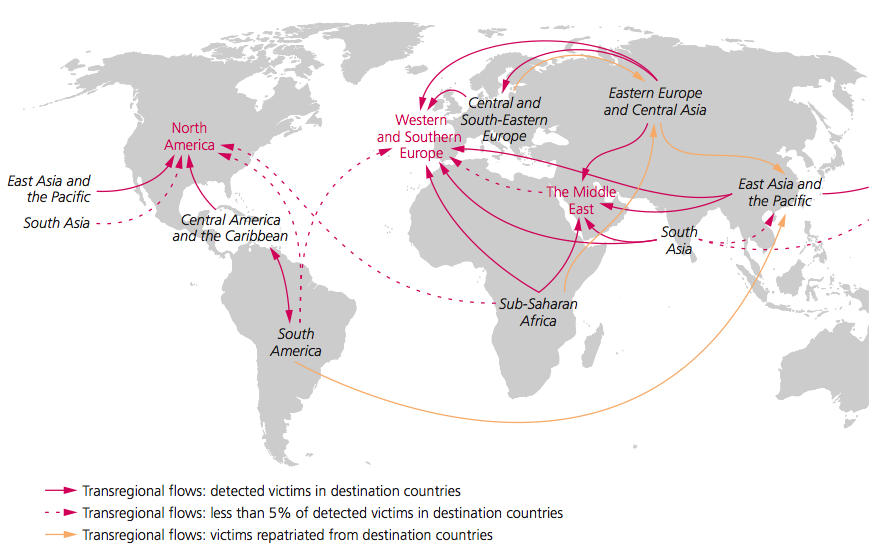
In Western and Southern Europe, detected victims held 137 different citizenships, particularly from Central and South-Eastern Europe (47%), Sub-Saharan Africa (16%) and East Asia (7%). Similarly, North American countries detected victims from more than 90 countries of origin. The most prominent trans-regional trafficking flow in the study was from East Asia, as 16% of the detected victims in North America are citizens of East-Asian countries. Trafficking victims from countries in Sub-Saharan Africa and East Asia are trafficked to the widest range of destinations. The UNODC found that 69 countries reported to have detected victims from Sub-Saharan Africa between 2012 and 2014.
Similarly, repatriation data show trafficking flows directed from sub-Saharan Africa to Eastern Europe, and Eastern Europeans trafficked to South-East Asia. Repatriation data also reveal that South American victims are trafficked to East Asia, and victims from Central and South-Eastern Europe are trafficked to Eastern Europe.
Number of citizenships among victims detected in destination countries, by subregion of detection, 2014-2017
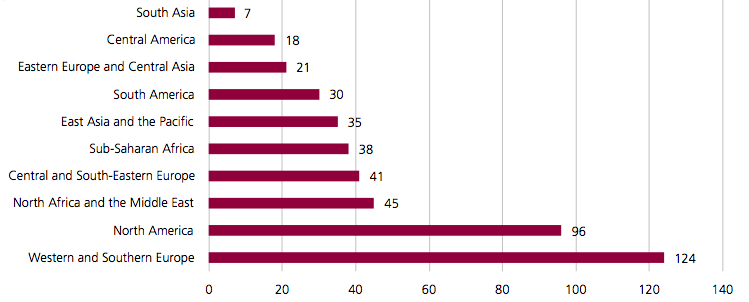
Considering data on detection and repatriation together shows that Western and Southern Europe, the Middle East and North America attract victims from a variety of origins. There is a wide range of citizenships among the victims detected in these three subregions.
Affluent countries in other areas, including in Eastern Europe and East Asia, are also destinations for some trafficking flows from distant origins. Many short-range trans-regional flows, such as between Central and South America, Central and Eastern Europe, sub-Saharan Africa and North Africa, also seem to be significant.
IMAGE CREDIT: IOM
